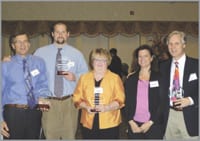Dollars-and-sense Strategies Tax Incentives for Your Practice — for a Limited Time Only
The focus of attention in the Economic Stimulus Act of 2008 was the rebate checks for individuals and married couples that got all the hype and media coverage. What received less attention were two fairly significant business tax incentives that medical and dental practices can avail themselves of.
If you are planning to make some substantial investments in new furnishings and equipment for your practice or to remodel an office you are leasing from another, 2008 is the year you should do this.
These incentives are available for purchases only through 2008 and, for certain property, only through 2009, so timing is very important.
Section 179 Expensing
The first incentive is an enhanced Section 179 expensing deduction. The law increases the amount of Section 179 property that you can purchase and expense in 2008 from $128,000 allowed previously to $250,000. This deduction is available for qualified property that is purchased and placed in service during your tax year that begins in 2008, provided the total amount of such property does not exceed $800,000. Above that amount, your deduction will be reduced until it is completely eliminated if the total reaches $1.05 million.
This incentive is for 2008 fiscal year only, so you have until Dec. 31, 2008 or the end of your fiscal year that begins in 2008 to take advantage of this.
Qualified property for Section 179 expensing generally must be newly purchased new or used tangible personal property that is actively used more than 50{06cf2b9696b159f874511d23dbc893eb1ac83014175ed30550cfff22781411e5} in your practice and for which a depreciation deduction would be allowed. This definition includes most medical and office equipment, computers, furniture, vehicles (with limitations), and some computer software. It does not include real property, air conditioning, and heating units. You should check with your accountant before purchasing property to be sure it qualifies.
Bonus Depreciation
Property that does not qualify for the Section 179 deduction may instead qualify for a new enhanced depreciation deduction. The new law provides qualifying taxpayers 50{06cf2b9696b159f874511d23dbc893eb1ac83014175ed30550cfff22781411e5} first-year bonus depreciation of the adjusted basis of qualifying property. This deduction can be claimed in addition to the Section 179 deduction and any other regular depreciation deduction.
What constitutes qualified property is a bit more complex than property qualifying for the Section 179 deduction. Unlike Section 179 property, it must be purchased new and, with limited exceptions, it must be purchased or constructed and placed in service during calendar year 2008, regardless of what fiscal year your practice may have. It cannot be acquired pursuant to a binding written contract entered into prior to 2008. The placed in service date is extended one year, through Dec. 31, 2009, for long production period property with a recovery period of 10 years or longer and for transportation property and certain aircraft. Also, there is no dollar limit on the expenditures for bonus depreciation.
The types of property qualifying for the allowance are as follows:
- Qualified leasehold improvements;
- Tangible property (depreciable life of 20 years or less under MACRS); and
- Off-the-shelf computer software
Qualified leasehold improvements include:
- Improvements made under a lease between unrelated parties;
- Improvements made either by the landlord or the tenant;
- The improvements must be made to the interior of the current space. Expenditures for common areas, expanding the building, improving the internal structural framework, etc. do not qualify;
- The building must be at least 3 years old (in actual age, not ownership); and
- Signed contract dates and in-service dates are a large factor in determining eligibility
The bonus depreciation for qualifying leasehold improvements can be significant. For example, take a $100,000 expenditure in 2008. Under the old rules this would have to be depreciated over 39 years, giving you a deduction in the first year of less than $2,500. With bonus depreciation this could be more than $50,000.
There are other related tax benefits to making this election. Unlike Section 179 deductions that limit reducing a taxpayer’s income to zero, the bonus depreciation rules have no limitations and allow losses to be created, thus enabling a taxpayer to carryback losses and possibly receive refunds on taxes paid in prior years. Also, a cost-segregation study performed on the total leasehold improvements expenditures could yield additional tax savings by reclassifying certain costs from real property (39 years) to personal property (5 to 7 years) and land improvements (15 years), thus making the write-off even greater.
As you can see, the tax-savings opportunities are enormous, but the window of opportunity is short. Planning is critical and you should engage your accountant in the process.v
James B. Calnan, CPA, is partner-in-charge of the Health Care Services Division of Meyers Brothers Kalicka, P.C., Holyoke, certified public accountants and business consultants; (413) 536-8510.

